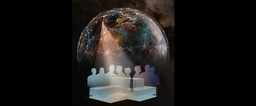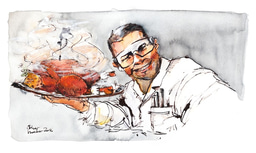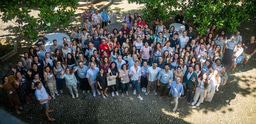FEBS Excellence Awardee spotlight: Miriam Stoeber

Miriam Stoeber is a group leader at the Department of Cell Physiology and Metabolism, Faculty of Medicine, University of Geneva, Switzerland. Following a PhD at ETH Zurich, Switzerland, she was a postdoc at the University of Oxford, UK and then at the University of California San Francisco, USA, before taking up her current role at the University of Geneva in 2019. Her research group is focused on understanding how the large family of therapeutically important G protein-coupled receptors (GPCRs) function in the cellular context. She received a FEBS Excellence Award (funds for equipment/consumables for early-career group leaders) in 2023.
What is your current research focus?
My team studies the large family of G protein-coupled receptors (GPCRs), which detect diverse stimuli and switch on signalling cascades that impact neurotransmission, immune responses, cell growth, and many other key physiological processes. We investigate how GPCRs drive cellular responses based on the exact ligand that is bound, including endogenous molecules and therapeutic drugs. We also study how the precise localisation of receptors in the cell determines their signalling output. Our research relies on the development of new tools that precisely sense and modulate elements of the GPCR signalling cascade. In particular, we employ single-domain antibody fragments called ‘nanobodies’, which currently have a large impact on basic research and drug development.
What’s exciting in this field at the moment?
For a long time, it was assumed that the plasma membrane is the only cellular site where GPCRs bind ligands and turn on signalling pathways. However, over the last decade, studies with high spatial and temporal resolution have established that many GPCRs can also be activated in intracellular organelles, which leads to distinct waves of signalling with unique functional outcomes. The recent discoveries show that ligand action at GPCRs is not only defined by the ability to activate receptors, but also by the subcellular site where ligands bind their target GPCR. Consequently, understanding how GPCR localisation affects pharmacology, and how these insights can be exploited to develop improved therapeutics, are currently exciting topics in the field.
What drew you to work in this area?
I developed a fascination for the intricate ways cells orchestrate dynamic processes while I was a Master and PhD student. During this time, I utilised high-resolution live cell microscopy and biochemistry to unravel the machinery that controls cellular update via endocytosis. Working with Sandra Schmid and Ari Helenius, two inspiring and dedicated scientists, I became confident that a career in academic research presented an exciting future endeavour. For my postdoc, I aimed to learn more about cellular communication and was lucky to join Mark von Zastrow’s lab. In his team, I started investigating the functions of GPCRs, right at a time when nanobodies had taken centre stage as research tools to capture receptors in distinct conformations. I had the opportunity to utilise nanobodies for the first time to detect opioid receptor activation in response to endogenous neuropeptides and opioid drugs. It was an exciting time since we discovered unanticipated differences in the cellular effects of opioid ligands, which built the foundation of my research plan as an independent investigator. By now, our methods and approaches have evolved and diversified, but we continue to tackle the many open questions and therapeutic opportunities in GPCR signal transduction.
How has time spent doing research abroad influenced your scientific career?
I have conducted my entire scientific career abroad, from my time as a Master student in San Diego, California, to becoming an independent group leader in Geneva, Switzerland. The ability to join buzzing research environments in the United States and several European countries has provided me with invaluable opportunities for professional and personal growth. Tackling scientific questions together with colleagues of diverse scientific and cultural background, who often became friends in the process, has shown me the power of creative, supportive, and multidisciplinary teams. It has also given me insights into different mentorship styles of young and advanced female and male group leaders and into the varied ways to run a lab – from well-structured to sometimes more free-spirited. Today, my group’s research strongly benefits from our international network of collaborators, and the acquired optimism that any scientific problem can be tackled with a creative, diverse, and dedicated team.
What would be your advice to PhD students and postdocs who would like to eventually start their own lab?
It is very helpful to build a network of scientific allies throughout all career stages. This can be achieved by frequently exchanging with peers rather than working in isolation: openly discuss your projects, ask many questions, dream with others about a crazy research idea, do activities together outside the lab. This will lead to interesting conversations and connections that will positively impact your research and your ability to communicate it. Since science is challenging and can be frustrating at times, seek out supportive and uplifting mentors who can boost your motivation when needed and will be able to open doors for you. Another piece of advice is to practice your scientific writing skills whenever you get the chance. I am currently spending most of my time writing grants, papers, and review articles, and luckily my PhD advisor Ari Helenius instilled in me a certain love for writing. Scientific writing skills will also help you secure PhD and postdoc fellowships, which will promote your path towards independence right from the start.
How have you found being a group leader?
If I would summarize my experience in one word, it would be ‘intense’. In the first months of starting the lab, I felt intensely joyful and excited to recruit the first team members, equip the lab, and run our team’s first experiments. But it was also challenging to get settled in a new research environment and learn about the institutional organization and culture. Since the COVID-19 pandemic hit just a few months after we had started up the lab, we improvised ways to stay connected within our young team. In addition, my second child had just been born and it felt challenging to navigate all the new responsibilities and tasks in my professional and private life. I think it is fair to say that early on I did not feel fully prepared for many of the duties that came with the role as a group leader. However, a year or two into the position, and after many conversations with my department colleagues and the attendance of a hands-on lab leadership course, I had acquired many new skills and methods for people and time management, conflict resolution, financial planning, mentorship, etc. The learning phase surely felt intense but was also extremely rewarding because I could see immediate positive effects, witness the growth of my team members, and celebrate first successes of awarded grants and submitted papers. Today, I feel better trained for the diverse job duties and for handling the unexpected situations that arise on a regular basis. I truly enjoy the work with my research team, colleagues, and students on a daily basis.
Top image of post: by Miriam Stoeber. An outing with the team high up in the Alps.





Join the FEBS Network today
Joining the FEBS Network’s molecular life sciences community enables you to access special content on the site, present your profile, 'follow' contributors, 'comment' on and 'like' content, post your own content, and set up a tailored email digest for updates.